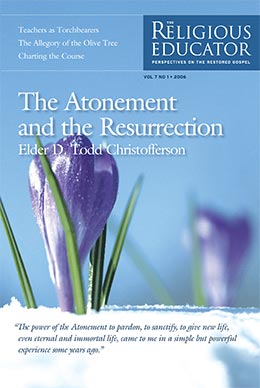Profiles of the Prophets: Gordon B. Hinckley
Lloyd D. Newell
Lloyd Newell, “Profiles of the Prophet: Gordon B. Hinckley,” Religious Educator 7, no. 1 (2006): 121–130.
Lloyd Newell was an assistant professor of Church history and doctrine at Brigham Young University when this was written.
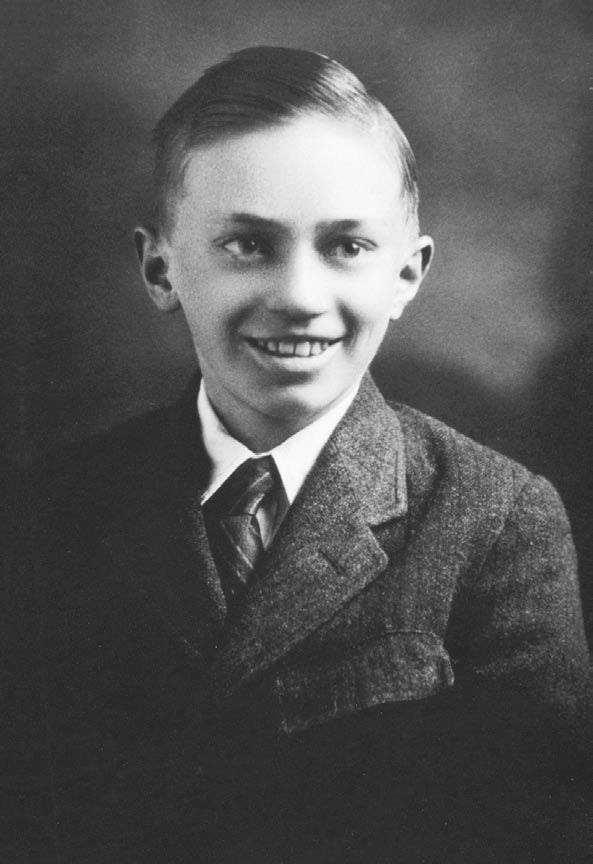 Gordon B. Hinckley as a boy
Gordon B. Hinckley as a boy
Born June 23, 1910, Gordon B. Hinckley, first child of Bryant and Ada Hinckley, was a “spindly, frail boy susceptible to earaches and other illnesses.”[1] He had allergies, hay fever, and whooping cough, which were aggravated by the smoke of Salt Lake City’s coal-burning stoves. Upon their doctor’s recommendation, the Hinckleys purchased several acres of farmland in the East Millcreek area, where they lived during the summer and where Gordon could breathe fresh air free from the smoke of the city. The summer home was a place of work and outdoor adventure. It was a place to tend animals, plant trees, and explore. Some nights were spent lying in the grass sleeping under the stars. The city home had a library with a thousand volumes. It was a place for Gordon to follow the habits of his parents in reading and pondering good books.
These two places of Gordon B. Hinckley’s childhood and young adulthood exemplify twin characteristics that are so much a part of him today. He loves the outdoors and has always spent time planting trees and flowers; he enjoys home repairs and projects and doesn’t mind getting his hands dirty. But he is also a man of letters and language, a person who is well acquainted with good literature.
Today he is still a mix of city and country. He can meet with heads of state, kings and queens from around the globe, but he can also can get his work clothes on, fix a toaster, plant a tree, weed a garden, and enjoy the beauty of God’s creations. He said of his childhood, “I learned to live around animals and learned the lessons of nature—the Profiles of the Prophets: Gordon B. Hinckley Lloyd D. Newell Lloyd D. Newell is an associate professor of Church history and doctrine at Brigham Young University. 122 beauty that is there and the penalties that come when nature in abused. We had large fruit orchards, and we learned how to prune trees. . . . In January, February, and March we pruned the trees, but we didn’t like it, because it was hard work. Yet we did learn something from it: You can determine the kind of fruit crop that you will have in September by the way you prune the trees in February. That was a great lesson, and it applies to people as well. You can pretty much determine the kind of adults you will have by the way you care for them as children.”[2]
Gordon’s first two decades overflowed with the happy, ordinary experiences of a joyful boyhood. This happiness was shaken by family heartache in 1930 when his beloved mother, Ada, died of cancer at age fifty. Even in death, his mother’s influence on her son was profound and lasting. Whenever he faced challenges, he thought of his courageous, faithful mother who was a constant influence for good in his life.
Gordon was an excellent student at Hamilton School, Roosevelt Junior High School, LDS High School, and the University of Utah, where he graduated in 1932 with a major in English and a minor in ancient languages. In 1932, at age twenty-two, Gordon wanted to attend Columbia University in New York City to study journalism, but the Lord had other plans for him—he was called to preach the gospel in the European Mission, with headquarters in London.
His first weeks of missionary work were discouraging and difficult. Suffering with hay fever and homesickness, he wrote home to his father that he felt he was wasting his time and his father’s money and that perhaps he should just return home. His father responded, “Dear Gordon, I have your recent letter. I have only one suggestion: forget yourself and go to work.” Elder Hinckley had a change of heart, and later said of that experience, “That July day in 1933 was my day of decision. A new light came into my life and a new joy into my heart. Everything good that has happened to me since then I can trace back to the decision I made that day in Preston.”[3]
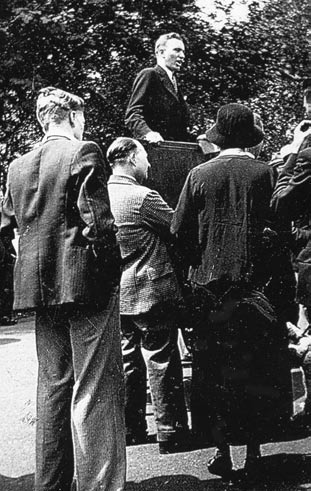 Elder Hinckley conducting a street meeting as a missionary
Elder Hinckley conducting a street meeting as a missionary
When Elder Hinckley returned from the mission field, his mission president had arranged for him to report to the First Presidency on the missionary work in the European Mission. A few days later, second counselor in the First Presidency, David O. McKay, who had been impressed with this newly returned missionary, offered him the position of executive secretary of the Church’s Radio, Publicity, and Mission Literature Committee. In this position, he wrote and produced hundreds of radio scripts, filmstrips, missionary pamphlets, public relations materials, and books for use in the mission field. Later he was asked by President McKay to find a way to present the temple ceremonies in various languages. This led to the production of a film version of the temple ceremonies in fourteen languages. This film version was first used in the Swiss Temple following its dedication in September 1955.
After years of dating and close friendship, Gordon married Marjorie Pay on April 29, 1937 in the Salt Lake Temple. They are the parents of five children: three daughters and two sons, and more than three score grandchildren and great-grandchildren. They are a close-knit extended family, unfailingly supportive of one another.
Gordon B. Hinckley’s early Church callings included service on the on the Sunday School General Board of the Church from 1937 to 1946. As part of this assignment, he wrote a manual for Book of Mormon study that was used in Sunday Schools for two decades. In 1946, he was called as Profiles of the Prophets: Gordon B. Hinckley second counselor in the East Millcreek Stake presidency and after that, he was called to stake president—becoming the third generation of Hinckleys to serve as a stake president. As a stake leader, he was known for his efficiency, diligence, wisdom, and a wonderful sense of humor.
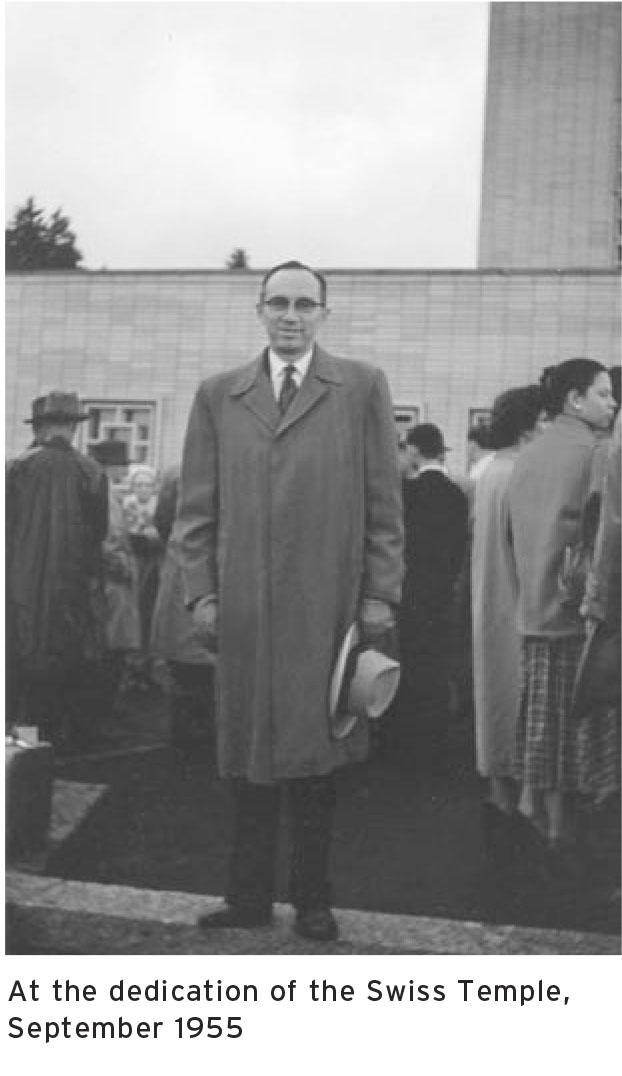
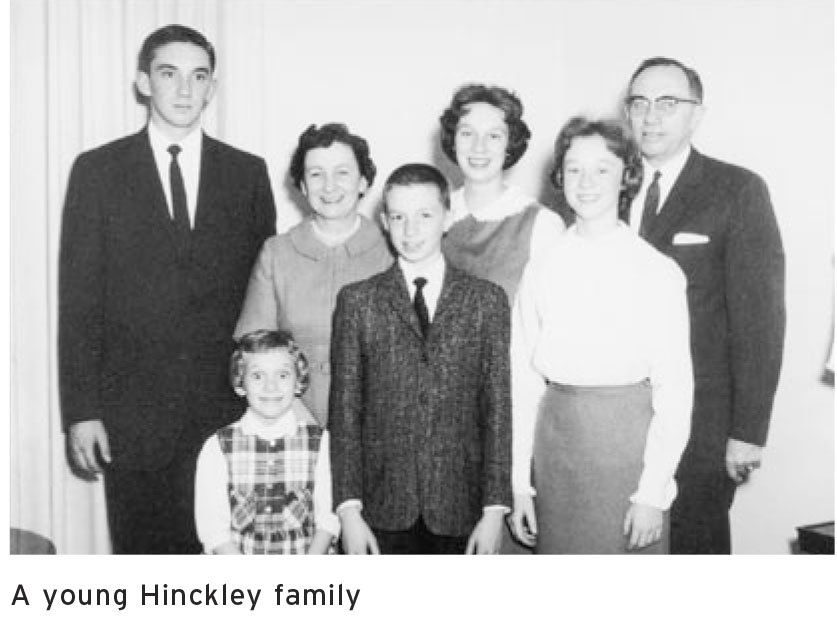
On April 6, 1958, President David O. McKay called him to serve as an Assistant to the Quorum of the Twelve. Two and a half years later, at the October 1961 general conference, he was sustained as a member of the Quorum of the Twelve Apostles (just three months after the passing of his beloved father). During his service as a member of the Twelve, Elder Hinckley was respected at Church headquarters and among the Saints for his devoted service and leadership, writing and speaking abilities, and good nature and kindly disposition. He supervised missions in Asia and in South America, and filled numerous headquarters assignments and committee responsibilities.
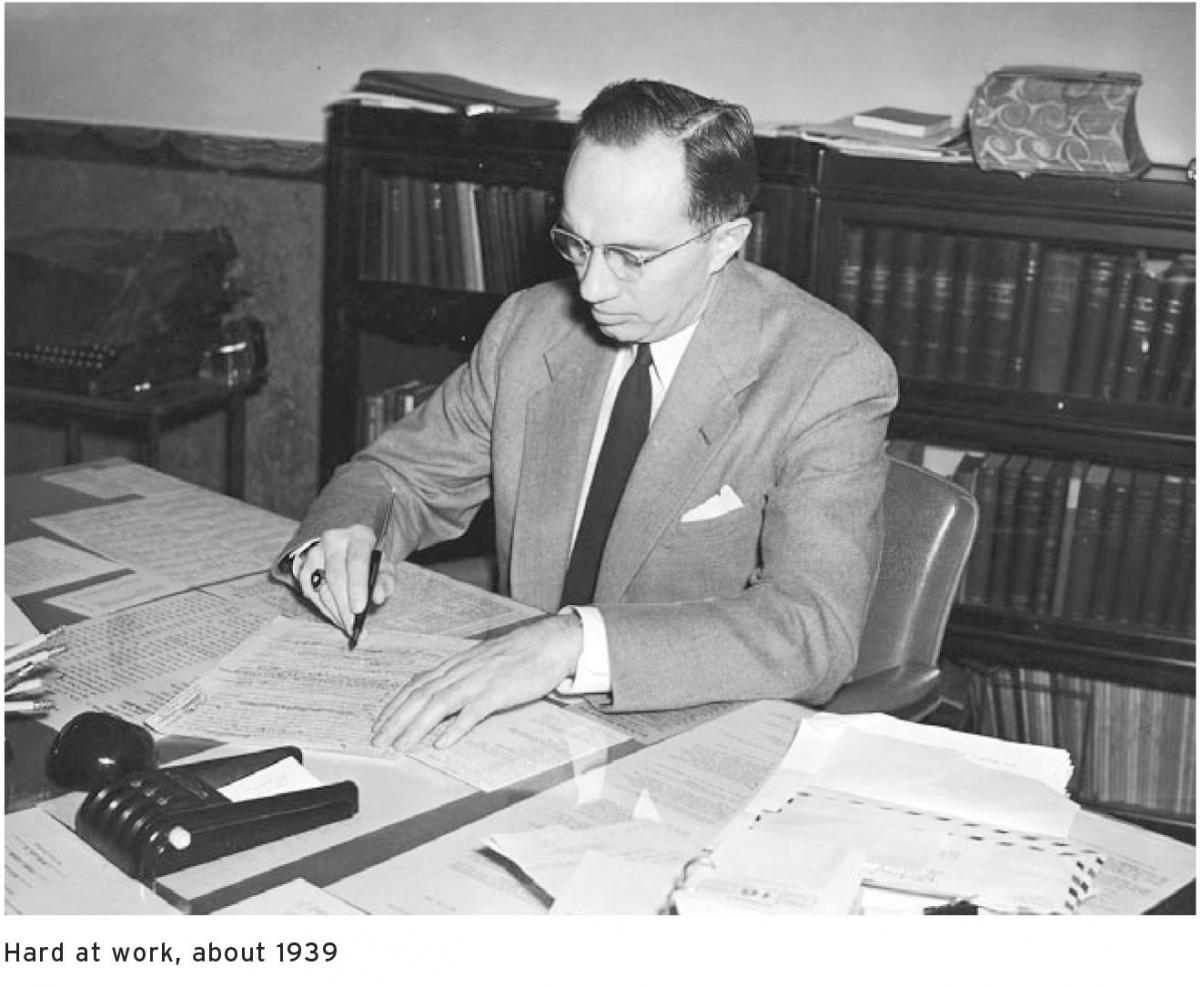
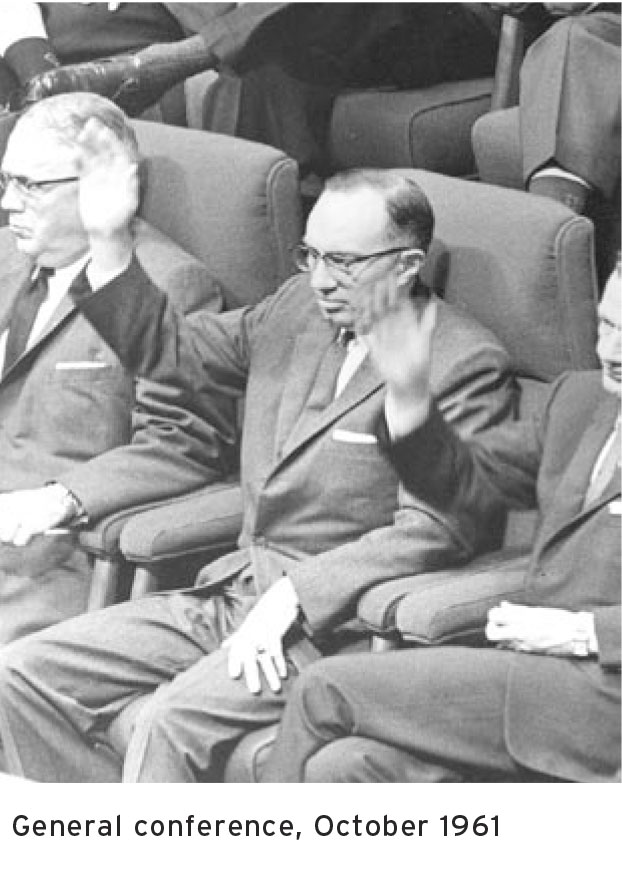
The next two decades would bring new callings and additional responsibilities. In July 1981, he was called by an ailing President Spencer W. Kimball to serve as an additional counselor in the First Presidency. In December 1982, upon the passing of Nathan Eldon Tanner, Gordon B. Hinckley was called as second counselor in the First Presidency. With the death of President Kimball in November 1985, President Hinckley was called as a first counselor to new Church President Ezra Taft Benson. Nine years later, upon President Benson’s death in 1994, he was again called to serve as the first counselor to a new president, Howard W. Hunter. Each of these three presidents experienced age-related illnesses, and during that time President Hinckley carried much of the day-to-day responsibility for the administration of the Church.
On March 12, 1995, President Gordon B. Hinckley was ordained and set apart as the fifteenth President of the Church of Jesus Christ of Latter-day Saints. During a news conference the next day, a reporter asked him about his focus and the theme of his administration. Without missing a beat, he answered, “Carry on. Our theme will be to carry on the great work which has been furthered by our predecessors.”[4] With his theme of carrying on this great latter-day work, he has expanded and accelerated the growth and mission of the Church in unique and important ways. Profiles of the Prophets: Gordon B. Hinckley
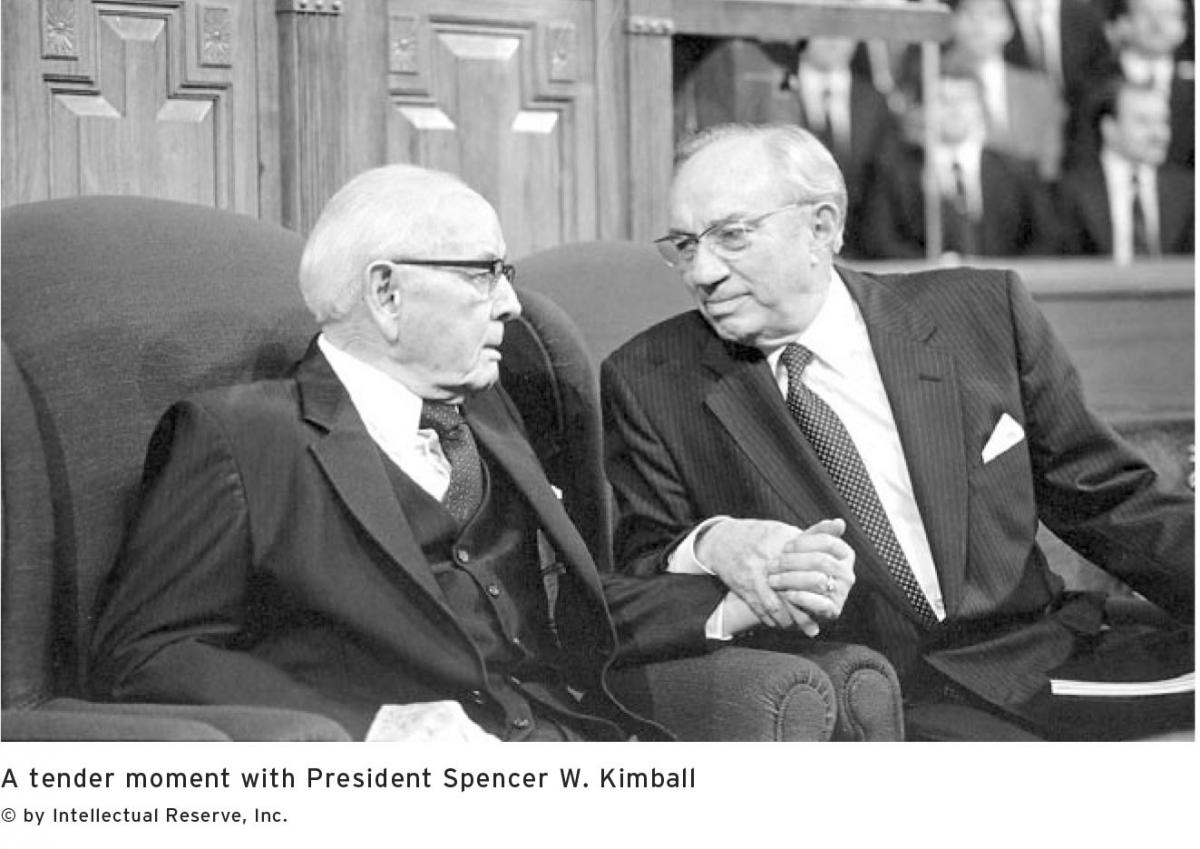
Except for a brief two-year interlude during World War II (when he worked for the Denver & Rio Grande Railroad), President Gordon B. Hinckley has spent more than seventy years either as an employee or General Authority of the Church. No one in the history of the Church has worked for more years in more assignments at Church headquarters than he has. Both professionally and in his Church service, he is known for his intelligence and diligence, his responsiveness and creativity, his complete commitment to the gospel and the work of the Lord.
Milestones of a Remarkable Presidency
Some of the milestones and hallmarks of President Hinckley’s leadership include temple building, the proclamation on the family, construction of the Conference Center, the Perpetual Education Fund, the establishment of additional Quorums of the Seventy, interaction with the media, international Church growth, and interfaith outreach.
At the conclusion of the April 1998 general conference, President Hinckley announced a “tremendous undertaking,” a program to begin immediately to construct smaller temples across the earth that would bring the blessings and ordinances of the Lord’s house to more people. His prophetic leadership has increased the number of temples worldwide from 51 in 1998 to over 120 today, with the total announced or under construction at 131.
President Hinckley read “The Family: A Proclamation to the World” in the general Relief Society meeting of the Church on September 23, 1995. Underscoring its importance, this is only the fifth proclamation issued by the First Presidency and the Quorum of the Twelve Apostles in this dispensation. The proclamation sets forth fundamental gospel doctrine about marriage, family, gender, Heavenly Father’s plan of happiness, the sacred responsibilities of spouses and parents, and principles of successful marriage and family. It also provides a solemn warning that the disintegration of the family undermines society.[5]
I
Because the Church had outgrown the Tabernacle on Temple Square, President Hinckley announced plans to construct a new Conference Center on April 6, 1996. The 1.4-million-square-foot building was dedicated by President Hinckley during the general conference of the Church, October 8, 2000. The building seats 21,333 in the main Conference Center and 905 in the Little Theater, making it, possibly, the largest theater-type building in the world.
In the April 2001 general conference, President Hinckley announced a new official program of the Church, a “bold initiative” which was inspired of the Lord. The Church would establish a revolving fund, similar to the Perpetual Emigration Fund in the early days of the Church, which would bless generations of people to come. From the continuing contributions of faithful Latter-day Saints, a Perpetual Education Fund (PEF) has been created that extends loans to devout and ambitious young men and women so that they may borrow money to attend school. They then repay that which they have borrowed together with a small amount of interest designed as an incentive to repay the loan.
President Hinckley called Area Authority Seventies in the April 1997 general conference, a move toward a decentralization of the operation of the Church and greater efficiency in working with nations across the globe. Members of the Third, Fourth, and Fifth Quorums of the Seventy were called to serve for a period of years in a voluntary capacity in the area in which they reside. “We have established a pattern under which the Church may grow to any size with an organization of Area Presidencies and Area Authority Seventies, chosen and working across the world according to need.”[6] Today, these three quorums, as well as three additional quorums, work under the direction of General Authorities.
No Church leader has been interviewed and profiled by more media outlets around the world than has Gordon B. Hinckley. He has welcomed the media attention because he understands and respects journalists, and he knows that media coverage helps to spread the gospel message and continues to bring the Church out of obscurity. He has been interviewed by large publications including Time magazine and the New York Times to local newspapers and broadcast outlets in countries across the globe. He has appeared before the National Press Club, and was featured on 60 Minutes and Larry King Live.
President Hinckley has written numerous articles and books during his lifetime. Among them are Truth Restored, a concise history of the Church; Standing for Something: Ten Neglected Virtues That Will Heal Our Hearts and Homes (2000), a nationally published book that has sold over half a million copies and appeared on the USA Today and New York Times bestseller lists; and Way to Be: Nine Ways to Be Happy and Make Something of Your Life (2002), a national bestseller published by Simon & Schuster as a book of virtues for teenagers and their parents.
In 1910, when President Hinckley was born, the Church had 62 stakes with 398,478 members. As of December 31, 2004, there were 2,665 stakes with 12,275,822 million members worldwide. In addition, when President Hinckley was born, the vast majority of Church membership was centered in the Rocky Mountain region of the United States. As of 1996, the majority of Latter-day Saints now live outside of the United States.

A hallmark of President Hinckley’s presidency is his desire to reach out in love to others not of the Latter-day Saint faith and to extend a hand of friendship. Over the years, he has repeatedly denounced arrogance and self-righteousness among Church members, saying, “We must never forget that we live in a world of great diversity. The people of the earth are all our Father’s children and are of many and varied religious persuasions. We must cultivate tolerance and appreciation and respect one another. We have differences of doctrine. This need not bring about animosity or any kind of holier-than-thou attitude.”[7] As the Lord’s prophet to all the world, his motivation is love for all humankind and a desire that they may be partakers of peace in this life and eternal life in the world to come
On April 6, 2004, President Hinckley faced one of the greatest challenges of his life when his beloved wife, Marjorie Pay Hinckley, passed away. During their life together, President and Sister Hinckley shared an optimistic view toward the world, a love of books, a willingness to work, and a commitment to the Church.[8] Though the physical affects of age were visible in her later years, the love they shared was equally apparent. They walked the highway of life side by side for almost sixty-seven years. She traveled the world with him, meeting members of the Church and supporting her husband in his heavy responsibilities. President Hinckley described her legacy as wife and mother in this fitting tribute: “To her I give all the credit for the virtues of our family, including our children and our grandchildren and our great-grandchildren. She holds a very bright spot in their hearts. . . . My love for her extends over a very long period of time and I expect it will go on forever.”[9]

True to the theme of his administration, President Hinckley carried on, determined to serve to the best of his ability as long as the Lord required. In July 2005, President Hinckley celebrated his ninety-fifth year with a grand evening in the Conference Center. During this celebration, his friend Mike Wallace, the CBS news commentator, paid a tribute to the President as did other community and entertainment leaders. At an age when most are long retired, President Gordon B. Hinckley continues to serve as the Lord’s servant, determined to carry on in his service as leader of the Church.
Notes
[1] Sheri Dew, Go Forward with Faith (Salt Lake City: Deseret Book, 1996), 24.
[2] Janet Peterson, “Friend to Friend,” Friend, February 1987, 6.
[3] Quoted in Dew, Go Forward with Faith, 64. Profiles of the Prophets: Gordon B. Hinckley Gordon B. and Marjorie Pay Hinckley © by Don Busath 130.
[4] Jay M. Todd, “President Gordon B. Hinckley: Fifteenth President of the Church,” Ensign, April 1995, 6.
[5] “The Family: A Proclamation to the World,” Ensign, November 1995, 102.
[6] “May We Be Faithful and True,” Ensign, May 1997, 6.
[7] Gordon B. Hinckley, “The Work Moves Forward,” Ensign, May 1999, 4.
[8] Peggy Fletcher Stack, “Partner in Faith,” Salt Lake Tribune, April 7, 2004.
[9] KSL News, “Marjorie Pay Hinckley Dies at 92,” April 6, 2004.
